Accessibility in Digital Publishing 2025: Your Complete Guide to Creating Inclusive EPUBs
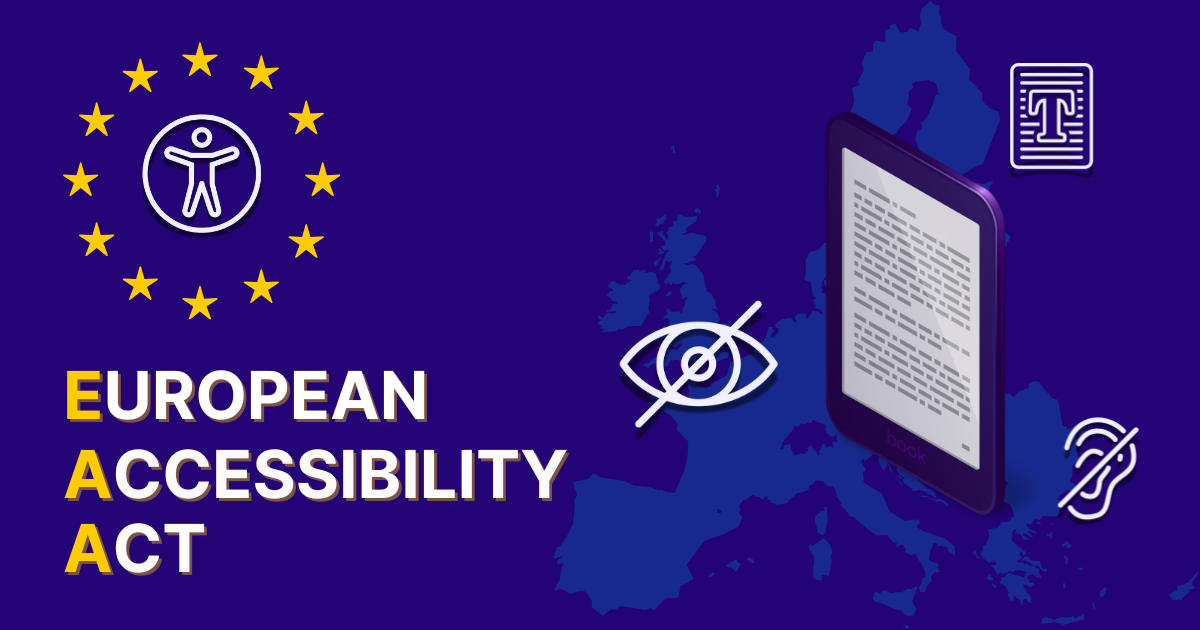
The digital publishing landscape is experiencing a seismic shift. As we move through 2025, accessibility isn’t just a nice-to-have feature; it’s becoming a legal requirement and business imperative. The bottom line: accessible ebooks aren’t just the right thing to do; they’re essential for reaching your audience and staying compliant with evolving regulations.
For independent authors and publishing companies, understanding accessibility in digital publishing has never been more critical. Whether you’re uploading your latest novel to PublishDrive or managing a growing catalog of titles, this guide will help you navigate the accessibility landscape and future-proof your publishing strategy.
The Accessibility Revolution is Here
The European Accessibility Act (EAA) was enacted on 27 June 2019 to come into force from 28 June 2025, marking a watershed moment for digital publishing accessibility. This directive doesn’t just affect European publishers - it impacts anyone hoping to sell ebooks in the EU market.
What does this mean for you? Publishers must comply by June 2025 and ensure all e-books are accessible to enter the EU market. The good news? If you’re an independent author or small publisher, titles published by microenterprises are exempt. Microenterprises employ fewer than 10 people or have an annual turnover of less than 2 million euros.
However, don’t let this exemption make you too relaxed. Retailers, libraries, and e-book platforms may begin rejecting non-compliant content to avoid hefty fines, which means accessibility could become a gatekeeping factor for distribution platforms.
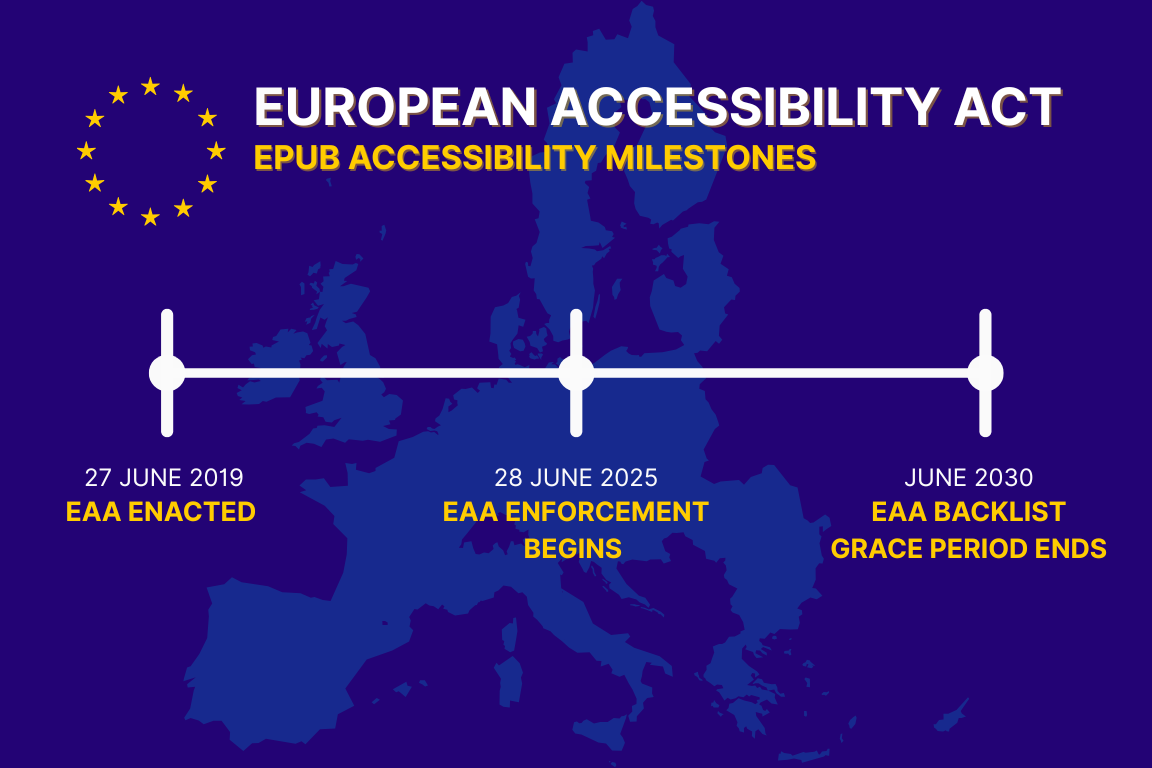
Understanding Accessibility in Ebook Publishing
Accessibility publishing means creating digital content that everyone can use, regardless of their abilities or disabilities. Approximately 20% of the world’s population falls into the category of ‘print disabled’, representing a massive underserved market.
Think accessibility is niche? Think again. Approximately half of all digital readers use accessibility features of some kind. This includes readers who adjust font sizes, modify background colors, use screen magnification, or rely on text-to-speech functionality; features that benefit everyone, not just those with specific disabilities.
Accessibility extends beyond compliance; it represents an opportunity to broaden audience reach and enhance the overall user experience for everyone.
The EPUB Accessibility 1.1 specification stands as a crucial standard in this evolving environment. It provides a definitive framework for ensuring that digital books are usable by a diverse readership, irrespective of their abilities or preferred reading methods. This specification builds upon established broader web accessibility principles, particularly the Web Content Accessibility Guidelines (WCAG), while meticulously addressing the unique structural and functional aspects inherent to EPUB publications.
A key aspect of this standard is its emphasis on making accessible qualities easily identifiable. This goes beyond simply meeting technical requirements; it ensures that a publication's accessible features are transparent to potential readers. When an EPUB is readily recognizable as accessible, it gains a distinct advantage in a market increasingly valuing inclusivity. This approach positions publishers who proactively adopt these standards as leaders in inclusive publishing, potentially attracting new user bases and fostering brand loyalty, thereby transforming accessibility from a compliance task into a significant market differentiator.
EPUB 3: The Gold Standard for Accessible Books
EPUB builds on the Open Web Platform, with HTML, CSS, JavaScript, and SVG as the core technologies used for content authoring. This foundation allows for creating highly accessible content using established web accessibility techniques.
Why EPUB 3 matters for accessibility:
Accessible EPUB3 is the “gold standard” in the publishing industry for producing accessible digital books. When properly implemented, EPUB 3 allows for:
- Screen reader compatibility
- Adjustable text size and fonts
- High contrast mode support
- Navigation aids like tables of contents
- Alternative text descriptions for images
- Synchronized audio and text
EPUB Accessibility 1.1 defines requirements for accessibility metadata. In this way, consumers can examine the accessibility characteristics of the content and make well-informed decisions on whether an EPUB publication is suitable for each need before buying, borrowing, or downloading it.
Understanding EPUB Accessibility 1.1: Goals and Scope
The EPUB Accessibility 1.1 specification is designed to address two fundamental needs within the digital publishing ecosystem, along with a broad scope of applicability that ensures its relevance across various contexts.
Two Primary Goals of the Specification
The specification's core objectives are twofold:
- Making Accessible Qualities Discoverable: A primary aim is to ensure that the accessible features of EPUB publications are easily identifiable. The specification mandates that all conforming EPUB publications include specific accessibility information, known as metadata, within their package documents. This metadata serves as a vital label, enabling users and reading systems to discern the accessible attributes of a publication quickly. This empowers consumers to make informed choices, determining if a publication aligns with their specific accessibility needs before they acquire or engage with it. This discoverability requirement is foundational for all EPUBs claiming conformance.
- The emphasis on discoverability as a primary need highlights that merely being accessible is insufficient; a publication must also be known to be accessible. The requirement for metadata, even if the publication does not meet complete accessibility optimization requirements, underscores this point. Without robust discoverability metadata, users with disabilities may struggle to find content tailored to their needs, which can limit the market for accessible content and consequently reduce incentives for publishers to create it. Conversely, strong discoverability fosters user confidence and expands market access, driving greater demand for accessible publications.
- Enabling Evaluation and Certification: The specification establishes clear, formal criteria for evaluating and certifying EPUB content as accessible. These requirements provide creators with a structured pathway for developing accessible content and facilitate independent verification of accessibility claims. This process builds trust within the digital publishing ecosystem, ensuring that an EPUB publication certified as accessible genuinely adheres to the detailed requirements outlined in the specification.
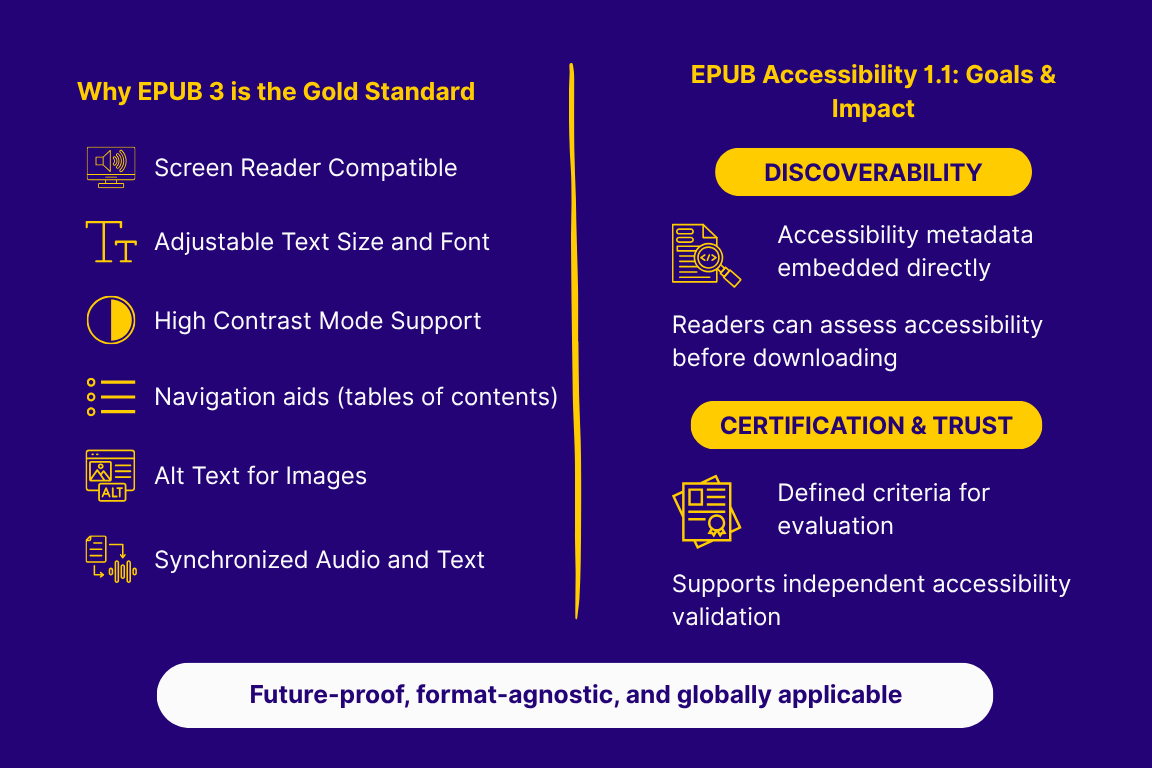
Broad Scope and Applicability
The reach of the EPUB Accessibility 1.1 specification extends broadly, ensuring its versatility and enduring relevance:
- Optimized Publications: The standard acknowledges that some publications may be optimized for specific reading modalities and thus might not meet all broad accessibility requirements. Even in such cases, adhering to the discoverability and reporting guidelines remains crucial. This allows users to understand any limitations and ascertain if the content still serves their particular needs, such as an EPUB specifically designed for users with specific visual impairments.
- Impact of Distribution: The specification recognizes that distribution channels and practices can significantly influence the accessibility and discoverability of content. It therefore underscores the importance of ensuring that accessibility metadata is carried consistently throughout the entire supply chain.
- Applicability to Older and Future EPUB Versions: A forward-thinking design principle of this standard is its applicability to EPUB publications conforming to any version or profile, including older versions that may not explicitly reference this specification, as well as future iterations of the standard. This abstract approach, similar to WCAG, ensures long-term relevance and stability, signifying a commitment to sustained usability rather than short-term compliance. This design reduces the burden on publishers to constantly re-evaluate against new specification versions, as the core principles remain stable, encouraging a deeper integration of accessibility into the publishing workflow rather than a reactive "patching" approach.
- Language Agnostic: The specification's abstract nature ensures that it addresses accessibility needs universally, regardless of the language a user reads, promoting full consumption of information irrespective of preferred reading modality.
The “Born Accessible” Revolution
The future of publishing lies in creating “born accessible” content. “Born accessible” refers to building accessible books right from the beginning, and building the process into current ebook production workflows, instead of taking apart and updating books post-production to make them accessible.
This approach offers several advantages:
- Cost-effective: It’s cheaper to build accessibility in from the start than to retrofit
- Quality: Born accessible books typically have better overall accessibility
- Efficiency: Streamlines your production workflow
- Future-proof: Meets current and anticipated future requirements
Digital content and technology have made it possible to get more materials to more people in more ways, and born accessible publishing is at the forefront of this transformation.
Making Your EPUB Discoverable: Essential Accessibility Information
For an EPUB publication to be genuinely accessible, its accessibility features must be easily discoverable by users and reading systems. This is primarily achieved through the inclusion of specific accessibility metadata.
The Power of Accessibility Metadata
Metadata functions as a descriptive label, communicating vital information about an EPUB's accessibility features or potential hazards. This empowers users to make informed decisions about whether a publication is suitable for their individual needs before they even open it.
Required Accessibility Metadata (Must-Haves)
Certain types of accessibility metadata are mandatory for all conforming EPUB publications:
- Access Mode: This describes the human sensory perceptual system or cognitive faculty required to process the content. Examples include "textual" for content primarily consumed by reading, "visual" for images or videos, "auditory" for audio content, or "tactile" for braille.
- Accessibility Feature: This details specific features and adaptations within the content that contribute to its overall accessibility. Examples include "alternative text" provided for images, "extended descriptions" for complex visual content, or "captions" for audio and video.
- Accessibility Hazard: This identifies any potential risks presented by the content that could affect users with particular sensitivities. Examples include "flashing" content (which can trigger seizures), "motion simulation" (which can cause motion sickness), or "sound" (referring to loud or sudden noises).
Recommended Accessibility Metadata (Good Practice)
While not strictly required, including the following metadata is considered best practice and significantly enhances discoverability:
- Accessibility Summary: This provides a human-readable overview of the publication's accessibility. It serves as a narrative description that complements the structured metadata, often highlighting any known deficiencies or specific strengths in accessibility.
- Access Mode Sufficient: This specifies one or more combinations of access modes that are sufficient to consume the content without significant information loss. For instance, a book might be fully consumable via "textual" or "auditory" means, indicating that both options provide a complete experience.
The distinction between required and recommended metadata is not arbitrary. Required metadata provides basic filtering capabilities, allowing users to identify if content is unsuitable for them quickly. Recommended metadata, such as the accessibility summary, offers a deeper, more human-centric understanding. This moves beyond a simple "yes/no" accessible flag to a nuanced description of how accessible a book is and for whom. This comprehensive and accurate metadata allows users to efficiently find content tailored to their needs, reducing frustration and increasing satisfaction, which in turn leads to higher adoption and trust in accessible EPUBs.
Important Caveat on Metadata Placement
A critical point regarding metadata placement is that while accessibility information can be referenced from external linked records, it must not be solely linked. Instead, it needs to be directly included within the EPUB's package document. This ensures that the essential accessibility information is always bundled with the publication, making it robust and immediately available to any reading system, regardless of external network conditions or support for external lookups. This rule prioritizes the user's immediate access to critical accessibility information over potential publisher convenience of centralizing metadata, underscoring the specification's user-centric design.
To provide a clear overview of these metadata types, the following table summarizes the essential accessibility information for EPUBs:

EPUB-Specific Accessibility Features: Enhancing User Experience
Beyond the foundational WCAG principles, EPUB Accessibility 1.1 outlines specific features that are particularly relevant to the digital book format, significantly improving the reading experience for diverse user groups.
Text and Structure
Proper heading structure is fundamental to accessibility. Screen readers rely on logical heading hierarchies (H1, H2, H3) to help users navigate content. Use semantic markup rather than just visual formatting—using actual heading tags rather than making text larger or bold.
Alternative Text for Images
Every meaningful image needs descriptive alternative text (alt text). While including meaningful photos, ensure they have text alternatives or are explained by the surrounding text. This will help visually impaired readers comprehend them. Decorative images should have empty alt text to prevent screen readers from unnecessarily describing them.
Navigation Features
Page navigation, which allows users to jump to specific page numbers, is a recommended feature under particular circumstances:
- When to Include: Page navigation is highly recommended if the EPUB is a dynamically paginated equivalent of a statically paginated publication (e.g., a print/digital bundle), if it is offered as an alternative to a static publication in predictable use environments (such as educational settings where consistent page references are vital), or if it is generated from a workflow that retains page break locations across different formats.
- Identifying the Source: If page navigation is included, it is essential to locate the source of the static page break locations, such as the ISBN or ISSN of the print edition. This provides context and verification for the page numbers. For digital-only publications that do not have a print equivalent, a source should not be specified.
- The Page List: A page list must be included, providing a navigable list of these static page break locations. This list should link to all reproduced pages from the source print edition and must link to all page break markers within the content.
- Page Break Markers (Optional): While including page break markers within the content is optional, if they are present and page numbers are read aloud as part of synchronized text-audio playback, these markers must be identified in the markup controlling the audio playback.
- A complete table of contents
- Logical reading order
- Landmarks for major sections
This nuanced guidance on page navigation demonstrates that accessibility is not a one-size-fits-all checklist. Features are most valuable when they meet a specific user need within a particular context. For instance, a digital-only novel might not benefit from static page numbers, whereas a textbook absolutely would. This encourages publishers to adopt a thoughtful, user-centric approach to accessibility, rather than applying every possible feature.
Clear Language and Structure
Using clear and concise language while designing an eBook is very important. This will help readers with disabilities understand the content of your eBook. Avoid overly complex sentences and jargon when possible.
Video and Audio Content
For multimedia content, provide:
- Captions for videos
- Transcripts for audio content
- Audio descriptions for visual elements in videos
Synchronized Text-Audio Playback (Optional, but with Clear Objectives if Present)
While providing synchronized text-audio playback is optional, if it is included, specific objectives must be met to ensure its effectiveness for auditory readers:
- Completeness: All visible textual content and any textual alternatives for visual media must be available in the synchronized audio. This ensures that auditory users receive the full content of the publication.
- Logical Reading Order: The synchronized text-audio playback should generally reflect the order of EPUB content documents in the spine and the order of elements within each document. If a different order is used (e.g., for pedagogical reasons or to prioritize certain information), it must still result in a logical and understandable playback experience for the user.
- Skippability: Secondary content, such as footnotes, endnotes, or page break markers, should be identifiable as "skippable." This allows users to easily bypass these sections if they are not relevant to their immediate focus, improving the flow of the primary content.
- Escapability: Highly structured content, such as sidebars, lists, or figures, should be identifiable as "escapable." This feature allows users to quickly move into and out of these sections, significantly improving navigation efficiency for auditory readers who might otherwise get lost in complex structures.
- Navigation Document Playback: Providing synchronized text-audio playback for the EPUB's navigation document (e.g., the table of contents or index) is crucial. This enhances the experience for auditory readers by allowing them to effectively use the book's navigation aids, just as visual readers would.
These detailed requirements for synchronized text-audio playback extend far beyond merely reading text aloud. Concepts like "skippability" and "escapability" represent sophisticated user experience considerations for auditory learners. They acknowledge that users need to navigate and interact with content efficiently, much like visual readers scan and skip sections. Implementing these features significantly reduces cognitive load and frustration for auditory users, improving comprehension and engagement, and ultimately making EPUBs genuinely usable for a broader range of learning styles and disabilities.
Reporting Your EPUB's Accessibility: Transparency and Trust
Transparently communicating an EPUB's accessibility status is vital for building trust among users and within the broader publishing ecosystem. This involves clear conformance statements and detailed information from the evaluator.
The Publication Conformance Statement
Every accessible EPUB must include a clear statement within its metadata. This statement specifies which version of EPUB Accessibility the publication conforms to, along with the WCAG version and the achieved conformance level (e.g., "EPUB Accessibility 1.1 - WCAG 2.2 Level AA"). This acts as a verifiable claim of accessibility, providing immediate assurance to users and distributors.
Evaluator Information (Building Credibility)
To further enhance credibility and accountability, information about the accessibility evaluation should be provided:
- Evaluator Name: The name of the party that evaluated the publication for accessibility is required.
- Evaluation Date (Optional): If known, the date on which the evaluation was conducted can be included, providing timeliness to the accessibility claim.
- Evaluator Credentials (Optional): Any relevant credentials or certifications of the evaluator can be specified, further adding to their credibility and expertise.
- Evaluator Report (Optional): If a publicly available, detailed accessibility report exists, a link to it can be provided. This offers complete transparency, allowing interested parties to review the specifics of the evaluation.
These detailed requirements for conformance statements and evaluator information go beyond simple self-declaration. By requiring the evaluator's name, their credentials, and a link to a public report, the specification establishes a framework for accountability. This allows users, institutions, and distributors to verify claims, thereby building confidence in the accessibility of the content. This approach transforms accessibility from a hidden technical detail into a transparent, verifiable attribute, which in turn leads to increased trust and greater adoption of accessible EPUBs, incentivizing more publishers to invest in genuine accessibility efforts.
Guidance on Re-evaluating Conformance
Accessibility is not a static state but an ongoing commitment. Content should be re-evaluated for accessibility when substantive changes are made to its structure, functionality, images conveying information, formatting that affects readability, or interactive controls. Minor changes, such as correcting typos or updating decorative photos, do not necessarily require a complete re-evaluation. However, if the underlying accessibility standards themselves have changed or been updated, an updated evaluation is recommended to ensure continued compliance and best practice. This guidance acknowledges that content is dynamic and standards evolve, preventing a "set it and forget it" mentality. It ensures that accessibility remains current even as the publication or the underlying standards change, encouraging publishers to integrate accessibility checks into their content lifecycle management, treating it as an integral part of updates and revisions.
Ensuring Accessible Distribution and User Privacy
Beyond the creation of accessible content, the EPUB Accessibility 1.1 specification also addresses crucial considerations related to the distribution of publications and the protection of user privacy.
Distribution Considerations
- No Restrictions Impairing Assistive Technologies: Publishers are explicitly prohibited from imposing restrictions, such as certain Digital Rights Management (DRM) settings, that prevent assistive technologies from accessing or interpreting the content. This is a critical provision, ensuring that commercial protection measures do not undermine efforts to make content accessible. This highlights a significant conflict point where DRM, often used to protect intellectual property, can inadvertently block assistive technologies that need to access and interpret the underlying content. This clause forces publishers to prioritize accessibility over certain restrictive DRM implementations, suggesting a need for innovation in DRM solutions that are compatible with accessibility standards, or a re-evaluation of business models that rely on overly restrictive DRM, particularly for educational or public access content.
- Include Metadata in Distribution Records: When distributing EPUBs through various channels, it is essential to include accessibility metadata in the record formats used for distribution (e.g., ONIX or MARC 21), provided those formats support such information. This ensures that accessibility information is carried consistently throughout the supply chain and ultimately reaches end-users, enabling them to discover accessible content effectively.
Privacy and Security
- No New Privacy/Security Issues from Authoring: The act of authoring accessible content or including accessibility metadata does not inherently introduce new privacy or security concerns for the publication itself.
- Reading System/Bookstore Responsibilities: Developers of reading systems and online bookstores bear a responsibility to protect user privacy. They should avoid creating user profiles based on accessibility needs without obtaining explicit user permission and providing easy options for removing such data. Furthermore, they should maintain the privacy of such information and refrain from mining search data related to accessibility characteristics. This section goes beyond the EPUB file itself, extending responsibilities to the broader ecosystem. This is a proactive ethical stance, anticipating potential misuse of sensitive user data (like accessibility needs) for profiling or targeted advertising. By explicitly stating that such profiling should be avoided without permission, the specification establishes a firm ethical boundary for the broader ecosystem, fostering a more trustworthy environment for users with disabilities and encouraging wider adoption of accessible digital content.
Tools and Resources for Creating Accessible EPUBs
PublishDrive implements several automatic actions during the ebook processing workflow to help publishers comply with accessibility standards. These actions work for future and existing ebooks.
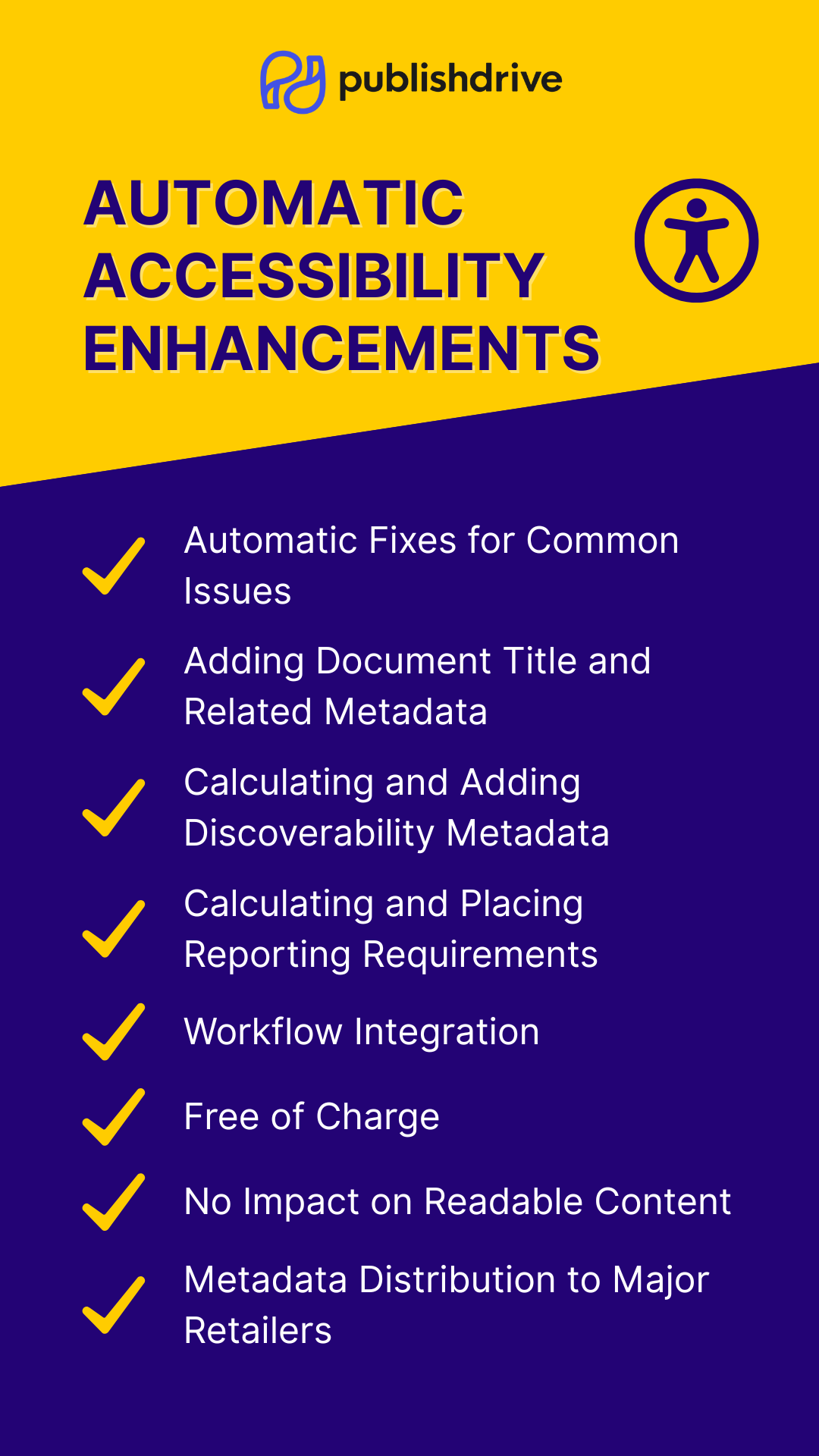
- Automatic Fixes for Common Issues: PublishDrive automatically addresses common formatting issues that might prevent content from being evaluated as accessible. This includes converting files to EPUB3 format, adding language declarations for each chapter, and ensuring that all images with content meaning have appropriate alt texts. It also fixes incomplete link texts.
- Adding Document Title and Related Metadata: The platform automatically adds document titles and other relevant metadata to the EPUB file.
- Calculating and Adding Discoverability Metadata: PublishDrive automatically calculates and embeds essential discoverability metadata into the EPUB, such as accessibility features, accessibility hazards, access mode, and sufficient access mode. This accessibility metadata is extracted from the EPUB if already present, or calculated if not. It's important to note that the publisher cannot provide accessibility metadata during book upload.
- Calculating and Placing Reporting Requirements: The system automatically calculates and places reporting requirements within the EPUB, including the accessibility summary, certifier information, and EPUB conformance details.
- Workflow Integration: These accessibility fixes and updates are applied during the preprocessing stage after a PublishDrive customer uploads their ebook. The process includes automatic and manual reviews before publication.
- Service Availability and Cost: This accessibility "conversion" service will be applied to all books published or republished after June 27, 2025. The service is provided free of charge, as it is included in the standard book review process.
- Impact on Content: This process aims to transform a "not accessible" EPUB into an "accessible" one by adding technical fixes and necessary metadata. It does not affect the visible, readable content of the book. Publishers are not required to perform an additional review step before publication, though they can optionally check the accessibility at any time. If a book is already deemed accessible, PublishDrive does not alter its formatting or metadata.
- Metadata Distribution: The enhanced accessibility metadata is then sent to major online stores, including Amazon, iTunes, and Google Play.
Testing and Quality Assurance
Ace by DAISY, the free EPUB accessibility checking tool, has had a remarkable effect on publishers’ ability to test and check the accessibility of their content. Beyond automated testing, consider:
- Manual testing with screen readers
- Testing with different font sizes and contrast settings
- Validation across multiple reading devices
The Business Case for Accessibility
Market Expansion
Despite the 6.2 million people with a disability, fewer than 5% of published works are available in accessible formats. Creating accessible books opens your content to an underserved market segment.
SEO and Discoverability
Making books accessible helps with SEO and discoverability. The structured markup required for accessibility often improves how search engines understand and index your content.
Legal Compliance and Risk Management
Investing in accessibility will help mitigate legal risks and ensure that you will avoid litigation, avoiding costs and the brand damage associated with legal proceedings.
Enhanced User Experience
Accessibility features benefit all readers. Adjustable fonts help readers in low-light conditions, clear navigation aids help everyone find information quickly, and proper structure makes content easier to understand.
Actionable Advice for Publishers and Creators
To effectively implement EPUB Accessibility 1.1 and cultivate a truly inclusive publishing practice, consider the following actionable steps:
- Integrate accessibility into your workflow from the outset. Rather than treating accessibility as an afterthought or a separate remediation step, embed it into the entire content creation and production process. This represents a shift from a "compliance mindset" to an "inclusive design mindset," leading to higher quality, more robust, and genuinely usable publications for all, ultimately reducing remediation costs and expanding market reach. Look at PublishDrive’s platform, where accessibility is integrated for future books or any book that was published before and needs to be republished or updated.
- Prioritize required metadata, then build towards recommended best practices. Begin by ensuring all mandatory accessibility metadata is accurately included, then progressively incorporate recommended elements to enhance discoverability and user experience further.
- Test your EPUBs with assistive technologies. Gaining firsthand experience with how users interact with your content using screen readers, refreshable braille displays, or other assistive technologies provides invaluable insights into real-world usability.
- Invest in training for your teams. Equip authors, editors, designers, and production staff with the knowledge and skills necessary to create accessible content from the ground up.
- Stay informed about updates to WCAG and EPUB Accessibility standards. Accessibility is an evolving field, and continuous learning and adaptation are crucial. Regularly reviewing updates ensures that your publications remain current and continue to meet the needs of a diverse readership. This empowers publishers to view accessibility as a continuous improvement process, adapting to new technologies and user needs, which leads to sustained accessibility of content over time and a long-term positive impact on user experience and market reputation.
Looking Ahead: The Next Five Years
Regulatory Expansion
While the European Accessibility Act takes effect in 2025, similar regulations are expected to emerge globally. The Government of Canada and several provinces are working towards making Canada a more inclusive, barrier-free country, with the Accessibility for Ontarians with Disabilities Act setting accessibility standards by 2025.
Technology Evolution
The next five years will bring enhanced accessibility through:
- AI-powered alt text generation: Automated tools for creating image descriptions
- Advanced text-to-speech: More natural-sounding synthetic voices
- Improved navigation: Better tools for complex content like academic texts and graphic novels
- Enhanced multimedia: Better integration of video, audio, and interactive elements
Platform Requirements
As of 28 June 2025, customers can file complaints before national courts or authorities if services or products do not respect the new rules. Expect distribution platforms to become stricter about accessibility requirements to avoid liability.
Born Accessible as Standard
We seem to be at a tipping point, and we hope that accessibility becomes the norm within the digital publishing world and that ebook building blocks are finally equipped to serve all readers. By 2030, born accessible publishing will likely be the industry standard rather than an exception.
Common Misconceptions Debunked
✖️ Myth: Accessibility is expensive and time-consuming.
✔️ Reality: The most significant barrier reported was the cost and time required to implement accessibility related practices, but this perception often exceeds reality. Modern tools make accessibility implementation much easier, especially with the help of PublishDrive’s automated tools.
✖️ Myth: Only specialized readers need accessible features.
✔️ Reality: Almost a quarter (26%) adjust the colour for the text or background, 25% magnify the screen, and 13% use a screen reader among general ebook readers.
✖️ Myth: Accessible books look different or inferior.
✔️ Reality: Well-designed accessible books are indistinguishable from standard ebooks for most readers while providing enhanced functionality for those who need it.
✖️ Myth: Already published, non-accessible books will be withdrawn from stores
✔️ Reality: The EAA mandates accessibility for ebooks and other digital content, while backlist titles have a grace period until 2030
Your Action Plan for 2025 and Beyond
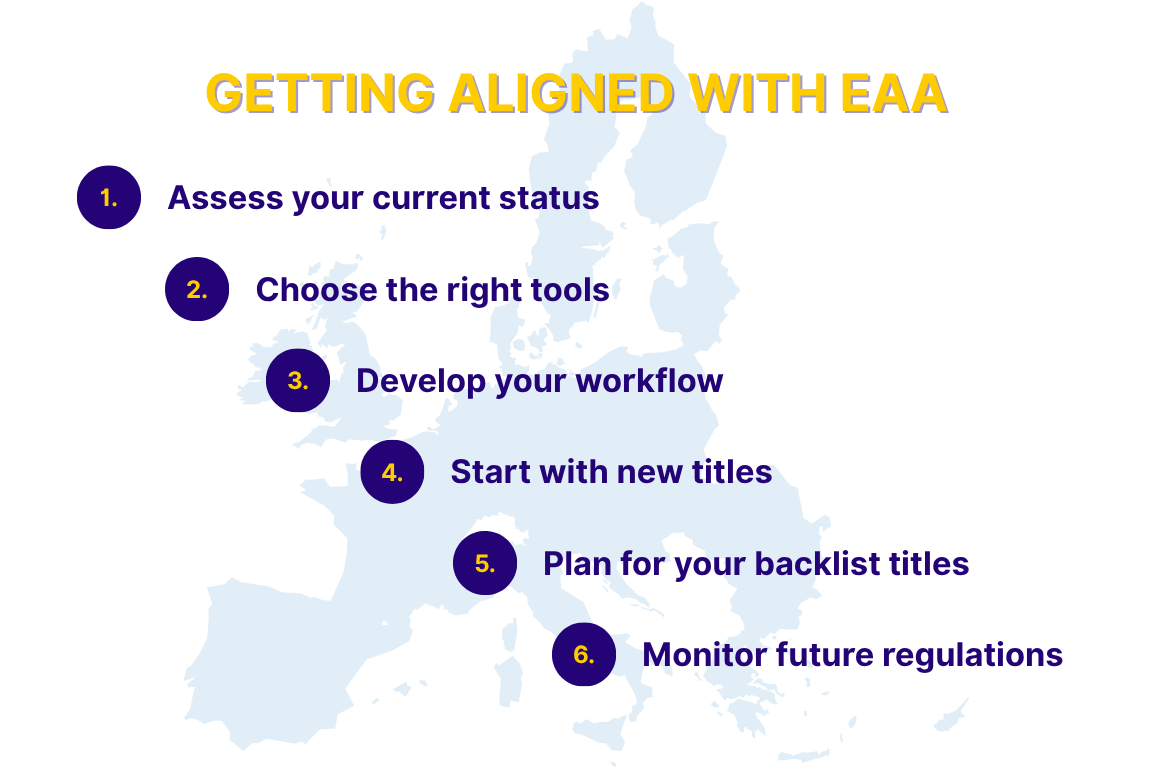
- Run your existing EPUBs through the Ace by DAISY checker
- Select creation and conversion tools that support accessibility features, such as PublishDrive’s tool
- Integrate accessibility checks into your production process
- Apply accessibility best practices to all new publications
- Develop a strategy for updating older titles based on sales performance and legal requirements
- Stay informed about accessibility laws in your target markets
The Future is Accessible
Accessibility in digital publishing isn’t just about compliance; it’s about creating better books for everyone. Accessibility isn’t just a trendy buzzword; it’s a commitment to readers that no one will be left out of the literary world, it’s a testament to the power of stories and knowledge.
As we move through 2025 and beyond, accessibility will become as fundamental to ebook production as proper formatting and cover design. Publishers who embrace this shift early will benefit from expanded markets, reduced legal risk, and the satisfaction of making literature truly universal.
The tools are available, the standards are clear, and the market is ready. So there’s no reason to think you just got a pass to not make your e-books accessible until 2025. Do it now!
Whether you’re a solo author uploading your first novel or a growing publishing house managing hundreds of titles, accessible publishing is no longer optional; it’s essential. By building accessibility into your workflow today, you’re not just preparing for tomorrow’s regulations but opening your stories to readers waiting far too long to join the conversation.
The future of publishing is inclusive, accessible, and bright. Make sure your books are part of that future.